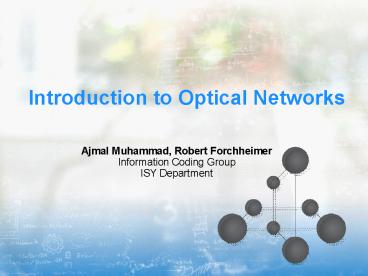Introduction to Optical Networks - PowerPoint PPT Presentation
1 / 27
Title:
Introduction to Optical Networks
Description:
Introduction to Optical Networks Ajmal Muhammad, Robert Forchheimer Information Coding Group ISY Department 3 Communication Systems Basic Blocks Three basic ... – PowerPoint PPT presentation
Number of Views:300
Avg rating:3.0/5.0
Title: Introduction to Optical Networks
1
Introduction to Optical Networks
Ajmal Muhammad, Robert Forchheimer Information
Coding Group ISY Department
2
Communication Systems
- Basic Blocks
- Coverage and Topology
- Three basic components
- Source and Transmitter
- Destinations and Receiver
- Communication channel (medium)
- Communication channel
- Wired
- Wireless
- Glass
- Water and or materials
- Coverage (public network)
- LAN
- MAN
- WAN
- Topology
- Bus
- Ring
- Mesh
- Star
3
Changing Service Landscape
- Network characteristics
- Full redundancy
- Fast restoration
- High availability (99.999 )
- Low latency
- High bandwidth
- Dynamic allocation and high bandwidth efficiency
- Support various services
- More providers and equipment builders (due to
deregulation of the telecom industry) - Providers are expected to provide more services
at higher capacity at lower prices! - A positive feedback business model!
- Need for high capacity network
- More users
4
Service Types
- Two basic service types (switching technologies)
- Connection-oriented
- Connectionless
- Connection-oriented
- Based on circuit switching (setup, connect,
tear-down) - Example Public Switching Telephone Network
(PSTN) - Originally only supported voice
- Not good for bursty traffic
- Connectionless
- Based on sending datagrams
- Examples Packet, message, burst switching
- Improves bandwidth and network utilization
5
Optical Fiber
- Allowing transmission of information using light
- Advantages
- High bandwidth
- Low noise
- Low interference (electromagnetic)
- Optical fiber installation
- Measured in fiber sheath-km (or fiber km)
- Example we install 3 fiber cable within 10 km
long route each fiber cable has 20 fibers ? we
have 600 fiber km - Currently more than 1.5 billion kilometers of
optical fiber is deployed around the world 1 - The circumference of earth is 40,000 Km!
1 http//www.corning.com/opticalfiber/innovation
/futureoffiber/index.aspx
6
Multimedia over Fiber
- Fiber carries various media
- Voice (SONET/Telephony) - The largest traffic
- Video (TV) over
- Hybrid Fiber Coaxial (HFC) or
- Fiber-Twisted Pair/Digital Subscriber Loops (DSL)
- Data Internet traffic
Triple Play
The Information Revolution would not have
happened without the Optical Fiber
7
Network Architecture
8
Elements of a Fiber Optic Link
9
Elements of OPTICOM System
- The Fiber that carries the light
- Single Mode Fiber (only one EM mode exists),
offers the highest bit rate, most widely used - Multi Mode Fiber (multiple EM modes exist), hence
higher dispersion (due to multiple modes) cheaper
than SMF, used in local area networks - Step Index Fiber two distinct refractive
indices - Graded Index Fiber gradual change in refractive
index
10
Elements of OPTICOM System
- Optical Transmitter converts the electrical
information to optical format (E/O) - Light Emitting Diode (LED) cheap, robust and
used with MMF in short range applications - Surface emitting and edge emitting LED
- LASER Diode high performance and more power,
used with SMF in high speed links - Distributed Feedback (DFB) Laser high
performance single mode laser - Fabry-Perot (FP) lasers low performance
multimode laser
11
Elements of OPTICOM System
- Optical Receiver converts the optical signal into
appropriate electrical format (E/O) - PIN Photo Diode Low performance, no internal
gain, low cost, widely used - Avalanche Photo Diode (APD) High performance
with internal (avalanche) gain - Repeater receives weak light signal, cleans-up,
amplifies and retransmits (O/E/O) - Optical Amplifier Amplifies light in fiber
without O/E/O
12
Development of Optical Networks
- First-generation optical networks
- Transmission in the optical domain (to provide
capacity) - Example SONET network (Synchronous Optical
Network) - Second-generation optical networks
- Wavelength routed network (Optical Circuit
Switching OCS) - More functionality in the optical domain (optical
networking) - Some of the routing, switching and intelligence
is moving into the optical domain - Third-generation optical networks (?)
13
Optical Networks
14
Transmission Window
15
Transmission Bands Capacities
Shannon theorem
16
WDM Grids ITU-T G.694.1
17
Overview of WDM
- A characteristic of WDM is that the discrete
wavelengths form an orthogonal set of carriers
that can be separated, routed, and switched
without interfering with each other. - WDM networks require a variety of passive and
active devices to combine, distribute, isolate,
and amplify optical power at different
wavelengths.
18
Optical Amplifier and EDFA
19
Inside an EDFA
20
Layered Model for Todays Networks
Current protocol stacks
21
Current Multiple Protocol Stacks
22 bandwidth used for protocol overhead
22
Towards a two Layer Network Architecture
A perfect combination
Flexibility Capacity
Less latency Higher bandwidth utilization
23
The Optical Layer
The optical layer provides lightpath service to
its client layers Lightpath optical
connection An optical channel trail between two
nodes that carries the entire traffic within a
wavelength
Client layers
24
Optical Layer Service Providing Lightpaths
- Bandwidth
- Adaptation to and from client layers
- Performance
- Bit error rate (BER)
- Optical signal quality (OSNR, impairments)
- Jitter
- Maximum delay
- Protection
- Fault management
25
Layers within the Optical Layer
- Optical Transport Network protocol layers
- Optical channel sublayer (OCh)
- Optical multiplex section (OMS)
- Optical transmission section (OTS)
- Physical media layer fiber-type specification
26
Simplified view of an Optical Connection
27
(No Transcript)

